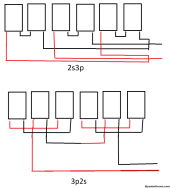The below diagram shows a 2s3p & 3p2s solar configuration respectively(at least I think that's what the configurations are called). I wired my 6 solar panels using the bottom example(3p2s) but afterwards I realized that I could wire them in a 2s3p configuration(top example).
Are these pretty much the same? Is there any benefit of going with one configuration over the other?
After reading this blog I believe both configurations need to be fused where the 3 hot lines come together. So the top example would need fewer fuses.
Otherwise, I think they're pretty much the same and will preform the same in shady conditions. Am I missing anything? Thanks.
Each panel is 240w. 38voc, 8a. 15a max fuse rating"

Are these pretty much the same? Is there any benefit of going with one configuration over the other?
After reading this blog I believe both configurations need to be fused where the 3 hot lines come together. So the top example would need fewer fuses.
Otherwise, I think they're pretty much the same and will preform the same in shady conditions. Am I missing anything? Thanks.
Each panel is 240w. 38voc, 8a. 15a max fuse rating"

Last edited:


